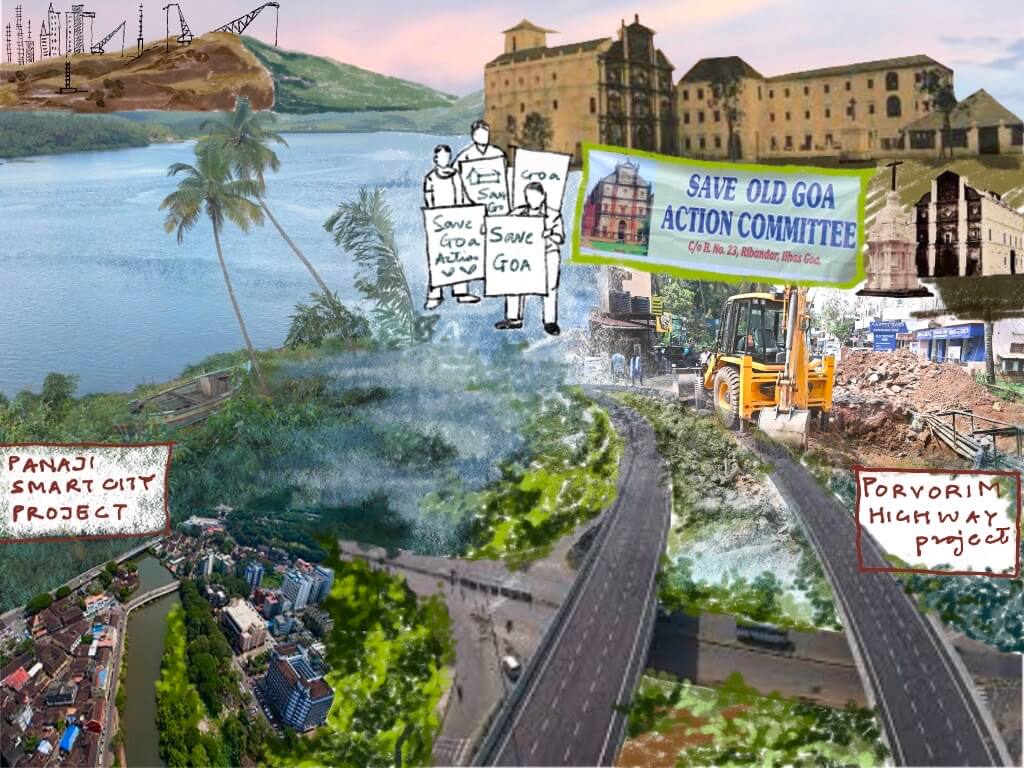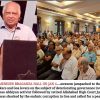Goa is abuzz with excitement as vintage bike and car owners, users, collectors and fans are decking […]

NO PLACE FOR GOANS IN GOA!
July 12- July 18, 2025, Life & Living July 11, 2025IT has been estimated that the average middle-class Goan, with a monthly family income of Rs50,000 per month or Rs6 lakhs per year, will have to save Rs10,000 per month for 50 years to buy and build his own house in Goa. When I bought my one and only 1BHK flat in Andheri in Bombay way back in 1980, it cost me Rs3lakh.
At that time, I was earning a salary of Rs4,000 per month, which is equivalent to at least Rs 50,000 if not Rs1 lakh in current income levels. I was lucky enough to get a loan from the Housing Development Finance Corporation to virtually cover 90% of the cost of the flat. HDFC, which has now merged with the HDFC bank, was the only financial institution that covered both the black and the white money that one had to pay to buy a flat.
The ratio of black to white, even in Goa, tends to be half and half. The loan period was for eight years, and the equated monthly installment was around Rs800 per month over an eight-year period. This represented almost 25% of my salary at that time in the early 1980s. I barely got Rs2 lakh from the sale of the flat in the mid-90s. Most of it was grabbed by my first wife because I was too ill at that time to get into an argument about my share from the proceeds of the sale of the flat. I had presumed that the value of the flat, which I bought at around Rs3lakh, must have doubled to Rs6 lakh in a decade, it was my ex-wife who was anxious to sell it while I lay in hospital sick, depressed with the thought that I may die anyway.
IN GOA
OUT of the proceeds of the sale of my Bombay flat and an additional loan from the State Bank of India, I bought a 1BHK flat at the Essar Residency in Taleigao for about Rs3 lakh. At that time, the area was undeveloped, and it was considered a good location on the main road from Taleigao to Santa Cruz, surrounded by green paddy fields on all sides.
I have never stayed in the flat for over 25 years since I bought it. Foolishly, I did not rent it out either. Even at the modest rent of Rs15,000 a month, I must have lost around Rs25 lakh or more, whatever is estimated to be the current value of the flat now. I probably will get even less because the building is in dire straits with water shortages. My bibi No.2 Tara Narayan goes and maintains occasionally and pays the outgoings. It’s a crowded location and continues to become more crowded with migrant tenants.
Relatively, as recently as 2006, I was offered a flat at Model “Status” at Dona Paula, which was just about ready for occupation, for ready for Rs15 lakh. By coincidence, my well-wishers had presented me with a purse of around Rs12 lakh on my 60th birthday. My better half did not like the building, and we lost the opportunity to purchase a flat for Rs15 lakh, which is now worth Rs2 crore plus.
Perhaps the last opportunity that middle-class Goans have for purchasing their own home was in the first decade of the millennium. The price of flats in all the new buildings like the Models Millennium was an average of Rs15 lakh for a 2BHK flat. The new housing complexes came with facilities like a swimming pool, a gymnasium, a gated community with security guards and some of them even had solar panels to provide electricity. Between 2005 and 2025, a period of two decades, prices of real estate shot up to the skies in Goa.
GOING IN CRORE PLUS
IN today’s Goa in 2025 the cost of even a 1BHK in Panaji would not be less than Rs 50 lakh. New 2BHK flats are being marketed at a minimum of Rs1.5 crore. There is no scope to buy an old flat as even the resale value of 30 to 40-year-old flats in the old Kamat Classic buildings exceeds Rs1 crore. Our NRI landlord, from whom we had rented a 3BHK flat in the Kamat Classic complex some three years ago told us to leave and sold it for upwards of Rs1.5 crore plus or minus.
In the housing complex where I am presently staying in a rental 2BHK flat the complex is also something like 30 years old plus, but similar old flats are being sold for about Rs70 lakh to a crore plus. Not just in Panaji but in all the major cities of Goa like Mapusa, Margao and Vasco and even Ponda, you cannot get a 2BHK flat in a good housing society for less than a crore.
It is the huge demand from wealthier “outsiders” from Delhi and Bengaluru, and even NRIs from London and Canada, which had pushed up property prices to astronomical levels. The trend of residents of Delhi buying a second holiday home in Goa started around 2010 and it has reached explosive proportions now. In the past, outsiders were primarily interested in holiday homes in the coastal belt as the beaches were the main attraction.
Over the last ten years, the focus has shifted to the green, quite, serene Goan villages. Goan villages are unique because they are highly developed and offer all urban facilities, even though they have the character of a village with agricultural fields weaving in and out. The swaying coconut palms have become the symbol of Goa. Over the last decade, not just villas but huge housing complexes have come up in traditional villages like Siolim and Saligao in the north and down south in Goa in Majorda and Betalbatim. Apparently, the sky is the limit as far as the Delhi and NRI investors are concerned. Over the last five years, super luxury villas costing on average Rs20-30 crore have been advertised at Reis Magos, which homes both the ancient fort and Reis Magos Church, including the Reis Magos jail. This is all hillside area being cut into which will undoubtedly have disastrous consequences in the future.
A huge super luxury complex is also coming up at Bicholim, which is considered the more conservative taluka of north Goa. At the prevailing prices, few Goans can afford even a 1BHK flat in Goa.
GOANS OR OUTSIDERS?
THE average salary in the private sector in Goa probably averages Rs20,000 per month for skilled jobs. A family can lead a respectable life only if other members of the family are also working. At the current level of inflation, it takes Rs50,000 to survive. If the old migrant residents or a Goan family decides to buy their own home, they will have to take a loan of at least Rs25 lakh. This would entail a minimum EMI of more than Rs25,000 a month. The problem with taking a loan is that the interest you pay over a period of ten years is almost equivalent to the cost of the flat. It takes time to reach a level where you are earning an average of Rs50,000 per month.
The only way a Goan can buy property is by selling his or her ancestral land or enter into an agreement with a builder to develop the property. Don’t blame the average Goan who has been selling his property to builders from outside Goa. The Uniform Civil Code has turned out to be a curse. This is because over a period of three generations, the property gets divided among such large families that that individual shares are very small and do not fetch much return, yet nobody wants to let go of their share or offer to another more needy family member.
Moreover, due to the Tenancy & Mundkar Act, even big bhatkar or landlords choose to sell their land holdings to builders as they do not have the time and energy to fight court cases over property issues.
There are some states in the country like Himachal Pradesh which do not permit outsiders to buy land in the state. Virtually every state in the country has a ban on the sale of agricultural land to outsiders. Goa is one of the few states that permits the sale of orchard and agricultural land to outsiders.
As a consequence, most of the land in Goa has now been sold to ruthless outsider builders. Forget about the coastal areas, many of the most beautiful villages of Goa have or are becoming concrete jungles. The “valley of flowers” in Assagao, once a tranquil green village the home of zayo flowers is now converted to another Gurgaon up north India. Gurgaon is the high rise high tech suburb of New Delhi.
In Goa our greedy TCP minister Vishwajit Rane, has openly sold Goa to the Delhi and Bombay builders. Vishwajit’s company, Karapur Agro, is a partner of the Delhi firm DHL in the super luxury villa project in Bicholim. Vishwajit Rane has even been convicted of distorting the Outline Development Plan, undermining the TCP Act to permit unregulated conversion of agricultural land and orchards.
Worse still land falling in the CRZ zone has also been sold after conversion in defiance of the rules. The Goa Bench of the Bombay High Court has put a stay on the illegal amendment to the TCP Act and the subversion of the ODP. The ODPs of the coastal villages of Candolim, Calangute and Parra have been cancelled by the High Court.
BUT all this will not bring down the price of land in Goa. The unfortunate part is that only rich bhaile from out of Goa or India can afford to buy land or property in Goa today. There is no place for Goans in Goa.














